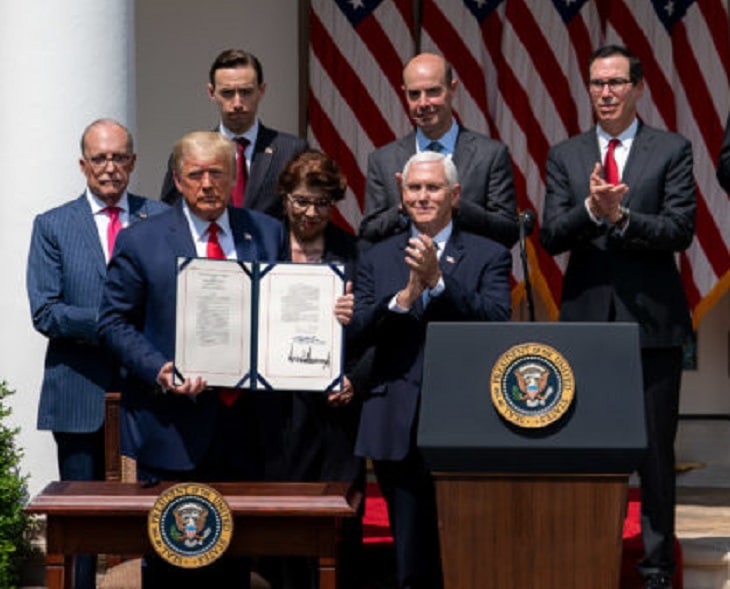On June 5, 2020, President Trump signed the Paycheck Protection Program Flexibility Act of 2020 (H.R. 7010) into law. The new legislation, which had bipartisan support and passed quickly through Congress, provides changes to provisions for loan forgiveness that are favorable to borrowers who received funds under the Paycheck Protection Program (PPP) created by the CARES Act. (See related posts below)
Since the PPP loan program began, there has been a steady stream of clarifications and additional guidance issued by the SBA and the Treasury to modify terms of loan eligibility as well as the forgiveness calculations. These clarifications, and in many cases, changes, have ultimately culminated in the passage of the PPP Flexibility Act. This new law is an attempt to make the PPP loans available and “forgivable” to as many employers/borrowers as possible. As is well known, the original intent of the program was to encourage employers/borrowers to keep their personnel on the payroll (and off unemployment) and to help organizations to survive during the COVID-19 pandemic.
While the final legislation was essentially identical to House bill 7010, passed on May 28, 2020, the most notable changes to the PPP loan bear repeating, now that the bill has been enacted into law.
The original PPP loan terms required the funds to be spent over an 8-week “covered” period, beginning with the receipt of the loan funds. This period was later adjusted with the introduction of an “alternative payroll covered period,” allowing employers/borrowers to use the eight-week (56-day) period that begins on the first day of their first pay period following their PPP Loan Disbursement Date.
Under the PPP Flexibility Act, the eight-week covered period has been expanded to 24 weeks (or until December 31, 2020), and is one of the primary provisions of the Act. Under this legislation, borrowers may elect to use their original (pre-PPP Flexibility Act) covered period, as opposed to the new 24-week period. This flexibility will allow those employers/borrowers that have already complied with the eight-week covered period requirements to move forward with their application for loan forgiveness.
Additionally, the original “75/25 rule,” which required 75% of funds to be spent on payroll expenses (and only 25% on qualified non-payroll expenses), has also been modified. Under the PPP Flexibility Act, employers/borrowers must use 60% of the loan for payroll costs.
UPDATE (6/9/20): While the original law was interpreted as providing zero forgiveness if less than 60% of the PPP loan proceeds were spent on payroll costs, clarification of this change allowing for partial forgiveness was released on June 8, 2020, through a joint statement issued by the SBA and Treasury. (See related post)
Other changes include the extension of the date by which employees need to be rehired from the original date of June 30, 2020, to December 31, 2020. However, it is unclear whether employers/borrowers who wish to retain the June 30 date as a “safe harbor” for employee rehiring can do so.
The PPP Flexibility Act also expands the “payback period” for that portion of the loan that is not forgiven to a minimum maturity of five years, up from the two-year term in the original bill. While the bill technically addresses this extension of the payback period for amounts borrowed only after the enactment of the law (June 5, 2020), employers/borrowers will recall that these terms may later be negotiated with any lender.
In addition, the new law also provides an extension of the period of time under which principal and interest, as well as fees, on the PPP loan can be deferred from the original six-month period to 12 months.
An important change in the full-time equivalent employees (FTEs) offers employers/borrowers a relief provision allowing for a determination of loan forgiveness without regard to a proportional reduction in the number of FTEs if an eligible recipient (the employer/borrower that received the PPP loan) is able to document in “good faith”:
- an inability to rehire individuals who were employees on February 15, 2020, and
- an inability to hire similarly qualified employees for unfilled positions before December 31, 2020, or
- an inability to return to operations at the level the business was at on February 15, 2020, due to compliance with governmental orders regarding required safety measures related to COVID-19 during the period March 1, 2020 and ending on December 31, 2020
The PPP Flexibility Act also adds a filing deadline for loan forgiveness, requiring that an application for loan forgiveness be made within 10 months of the last day of the covered period.
Importantly, and not directly related to the PPP loan itself, the new law eliminates the restriction included in the CARES Act that disallowed employers that were eligible recipients of PPP loans and that later had those loans forgiven, from taking advantage of the payroll tax deferral benefit.
GYF will continue to analyze the impact of these changes and post additional updates with further commentary. If you have questions about your PPP loan or the loan forgiveness application process, please contact Bob Grossman, Don Johnston or Mike Weber at 412-338-9300.
Related posts:
Senate Approves Paycheck Protection Program Flexibility Act of 2020
House Passes Bill to Provide Flexibility on Loan Forgiveness Requirements for PPP Borrowers
SBA Offers Additional PPP Loan Forgiveness Information
Bipartisan Paycheck Protection Program Legislation Appears to Be on the Way
Paycheck Protection Program Loan Forgiveness Application Released
Paycheck Protection Program Loans – Round 2
FAQs Issued to Further Clarify Guidance on PPP Loans
Paycheck Protection Program Loans (PPP) Available Under the CARES Act








